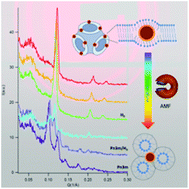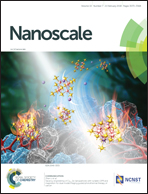On the thermotropic and magnetotropic phase behavior of lipid liquid crystals containing magnetic nanoparticles†
Abstract
The inclusion of superparamagnetic iron oxide nanoparticles (SPIONs) in lipid mesophases is a promising strategy for drug-delivery applications, combining the innate biocompatibility of lipid architectures with SPIONs’ response to external magnetic fields. Moreover, the organization of SPIONs within the lipid scaffold can lead to locally enhanced SPIONs concentration and improved magnetic response, which is key to overcome the current limitations of hyperthermic treatments. Here we present a Small-Angle X-ray Scattering (SAXS) structural investigation of the thermotropic and magnetotropic behavior of glyceryl monooleate (GMO)/water mesophases, loaded with hydrophobic SPIONs. We prove that even very low amounts of SPIONs deeply alter the phase behavior and thermotropic properties of the mesophases, promoting a cubic to hexagonal phase transition, which is similarly induced upon application of an Alternating Magnetic Field (AMF). Moreover, in the hexagonal phase SPIONs spontaneously self-assemble within the lipid scaffold into a linear supraparticle. This phase behavior is interpreted in the framework of the Helfrich's theory, which shows that SPIONs affect the mesophase both from a viscoelastic and from a structural standpoint. Finally, the dispersion of these cubic phases into stable magnetic colloidal particles, which retain their liquid crystalline internal structure, is addressed as a promising route towards magneto-responsive drug-delivery systems (DDS).

- This article is part of the themed collection: International Year of the Periodic Table: Applications for magnetic materials


 Please wait while we load your content...
Please wait while we load your content...